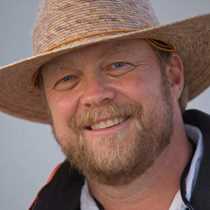Carcass Island, Falkland Islands
When on an expedition you learn to expect the unexpected. This goes for not only wildlife encounters, but also for changes in the weather. Today, even the experienced among us were caught by surprise.
The day began with flat, calm seas as the National Geographic Explorer approached the northwestern end of the Falkland Islands. In this part of the world, wind is a constant force driving ocean currents, building waves that relentlessly pound the windward side of the islands, and for creating the ideal flying conditions for albatross and other seabirds. But conditions this morning were so calm, in fact, that almost all of the black-browed albatross were sitting on the water. From a photographer’s point of view, it would have been great to have birds soaring against the rising sun, but this was not to be. Instead, early risers were rewarded with a group of bow-riding Peale’s and Commerson’s dolphins that escorted us to our anchorage in Pattison Bay at Carcass Island, where we made our first landing of the voyage.
Taking its name from the HMS Carcass, Carcass Island is owned by Rob and Lorraine McGill, longtime friends to Lindblad Expeditions and National Geographic. Here we went ashore to explore the tussock grass habitat and shoreline areas and to look for wildlife. Long walkers visited a nesting colony of Gentoo penguins and also spied Magellanic Penguins poking the their heads out of nesting burrows. A great variety of small birds were also observed, including the endemic Cobb’s wren and the colorful long-tailed meadowlark with its bright crimson breast. Many photos were made on this warm and sunny morning that we will share with friends and family back home, capped off by a lavish tea prepared for us by the McGill’s in their home closely watched by a gang of striated caracaras, known locally as Johnny Rooks. Indeed, peeling off layers, we found ourselves over-dressed.
The afternoon was a different story. By the time the National Geographic Explorer had re-positioned to West Point Island, the wind had kicked up, clouds moved in, and it began to drizzle rain. This caught many of us off guard after the warm and sunny morning. But the weather did not stop us from walking to the other side of the island, to a spectacular cliff area called the Devil’s Nose. Here a large nesting colony of black-browed albatross and rockhopper penguins is set against the backdrop of Cliff Mountain, with its sculpted rocks and pounding surf. Albatross are legendary birds that spend most of their life on the wing over the Southern Ocean, coming ashore only to breed and raise their chicks. The sky was filled with these magnificent soaring birds displaying their nearly 8-foot wingspan. Others were sitting on their single egg, which will be incubated by both parents for more than a month, or were engaged in pair bonding, courtship displays, and nest building and maintenance. It’s safety in numbers for seabirds, and the rockhoppers seemed right at home nesting among the albatross, all the while darting in and out of the tussock grass and providing comic relief with their frequent territorial disputes.
It was extremely challenging in the wind and rain to photograph all the action in front of us. This may have been a blessing in disguise, as the conditions caused us to observe more closely and choose moments more carefully to expose our cameras to the elements. It was truly humbling to be in the company of the albatross, who live 60 or more years, and to see them effortless flying just overhead. There is teamwork and wisdom here. As one guest remarked, “this experience alone has made it worth the trip!” And it also taught us to always carry our rain gear, for both ourselves and out cameras.




